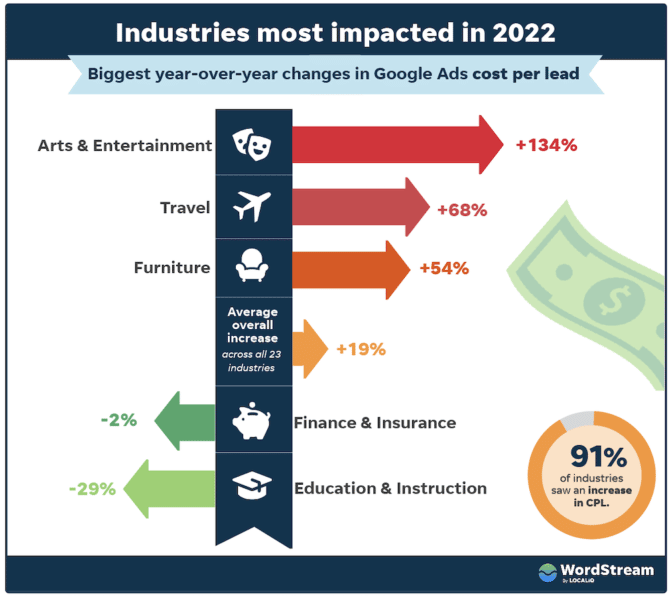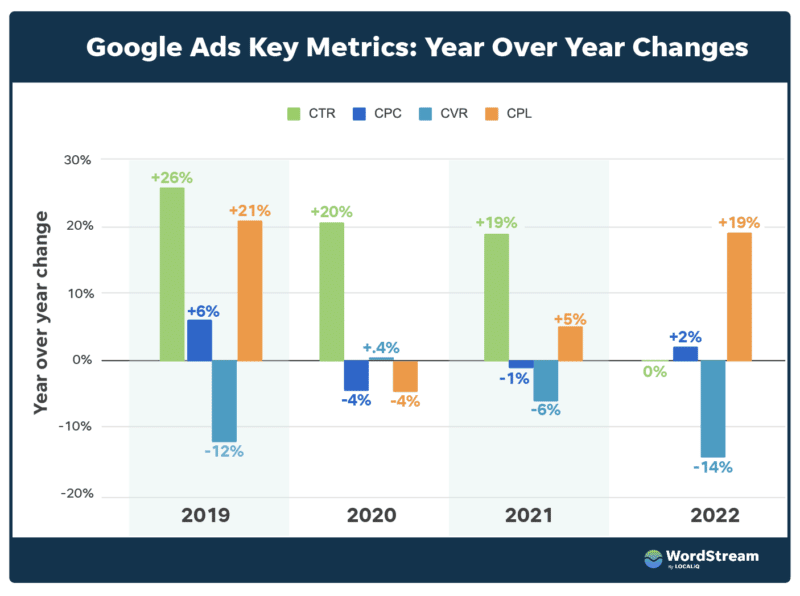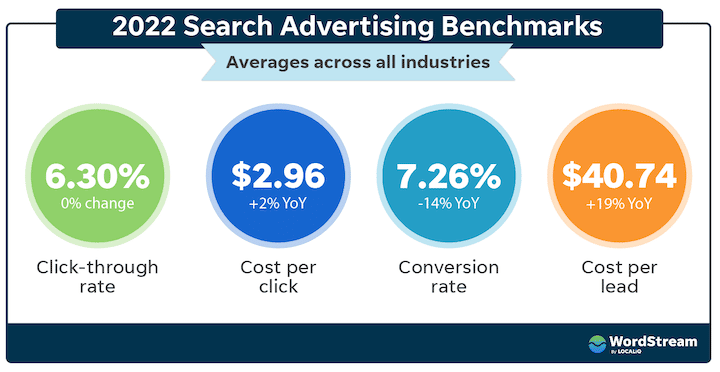New report shows Google cost per lead has increased for 91% of industries
The data was pulled from over 79K client campaigns running search ads from October 2021 through September 2022.
A new report shows that the cost per lead has increased for about 91% of industries in Google. The hardest hit industries are Arts & Entertainment (up 134%), Travel (up 69%), and Furniture (up 54%).
Industries that saw a decrease in cost per lead are Finance & Insurance (down 2%), and Education and Instruction (down 29%).

Making sense of the data. LocaliQ speculates that the reason for the increases is inflation, broad keyword matching, and competition.
It makes sense that the industries listed above are affected, since during and post-pandemic, people are looking for things to do outside the home, are traveling more often, and continuing to see supply shortages affecting furniture delivery.
Conversion rate decline. The report also shows a decrease in conversion rate, likely due to broad match keywords pulling in more general, top-funnel searches and clicks. 91% of industries saw a decrease of about 14% overall. To put that into perspective, in 2019 we saw a 12% decrease.
Cost per click (CPC). CPC has slightly increased slightly with about 57% of industries affected. In 2020 and 2021 there were also decreases in CPC (-4% and -1% respectively), but in 2019 there was a 6% increase.

Get the daily newsletter search marketers rely on.
See terms.
The numbers. The top five industries with the lowest cost per lead are:
- Automotive Repair and Service ($19.85)
- Physicians & Surgeons ($22.74)
- Sports & Recreation ($23.57)
- Arts & Entertainment ($25.46)
- Animals & Pets ($26.25)
Industries with the highest CPC are:
- Attorneys & Legal Services ($8.46)
- Dentists & Dental Services ($6.69)
- Home & Home Improvement ($5.74)
- Business Services ($3.80)
- Industrial & Commercial ($3.50)

You can view the entire list of top industries and their cost benchmarks here.
Tips to help businesses respond. To help businesses respond to these shifts, LocaliQ suggests the following best practices.
- Implement a full-funnel, cross-channel strategy to reach warmer audiences.
- Be proactive with negative keywords to combat broad targeting and reduce wasted spend. Since CTR hasn’t changed overall, we can gather that people are still clicking on ads just as much, but since the intent isn’t there, they’re not converting.
- Increase your paid search budget to keep up with ever-increasing competition in the space – not just in the new year but during the 2022 holiday season. If an increase in budget is not feasible, try to improve your ad relevance and Quality Score, optimizing your keywords, examining your competition, and more.
Dig deeper. Read the full article from WordStream here.
Why we care. It's always good to know where your campaign costs are in relation to industry benchmarks. If your brand or client is one of those most affected, it's likely because of the pandemic, inflation, or recent changes in keywords and automation. Follow best practices and continue testing to make sure your costs are under control.
Related Stories
New on Search Engine Land
Mastodon: The new way to connect with other SEO pros
New report shows Google cost per lead has increased for 91% of industries
Why is content marketing important? 9 reasons to use content
TikTok has launched an in-app ecommerce feature
The SEO career path: What it may look like and how to level up







